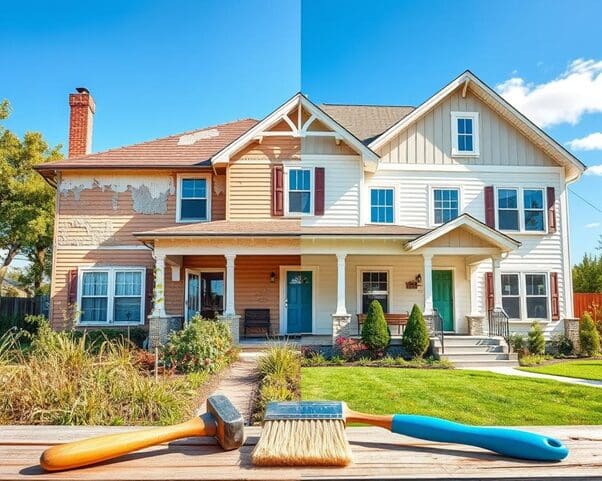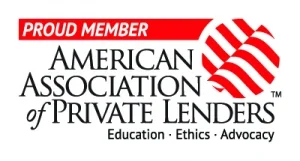Are you thinking about real estate investments but don’t know how to finance them? Fix and flip loans might be what you need. They offer a quick way to buy, fix up, and sell houses fast.

A fix and flip loan is made for those who want to renovate and sell houses. It’s different from regular mortgages because it’s meant for quick sales. The interest rates are usually between 8% and 12%, making these loans unique.
Traditional banks usually don’t offer these loans. Instead, hard money lenders and private investors are the go-to for house flipping loans. They provide fast money, often in days, helping investors grab good deals quickly.
If you’re new to real estate investing, learning about fix and flip loans is key. The application is fast, taking less than five minutes. You can also learn more about hard money here.
Key Takeaways
- Fix and flip loans are specialized for short-term property investments.
- Typical interest rates range between 8% and 12%.
- Main funding comes from hard money lenders and private investors.
- Application processes can be completed in minutes.
- Fast funding facilitates quick property purchases and renovations.
Introduction to Fix and Flip Loans
Fix and flip loans are key for real estate investors who fix up properties to sell for a profit. These loans offer short-term funding for the purchase, renovation, and other costs. They are made for the unique needs of house flipping.
Investors get fast funding and flexible terms with these loans. Unlike bank loans, fix and flip loans are processed quickly. This allows investors to make quick decisions in a competitive market. They are also available to a wider range of investors, starting at a credit score of 660.
There are different types of fix and flip loans, like investment property loans and residential bridge loans. Investment property loans can finance up to 90% of the purchase price. Residential bridge loans help bridge the gap between buying and selling properties.
Property renovation loans cover the high costs of refurbishment. These loans rely on the After-Repair Value (ARV) to finance up to 75% of it. This ensures enough support for renovation, boosting investor profits.
Fix and flip loans are interest-only during the renovation phase. This helps investors keep cash flow. Renovation funds are held in an escrow account, released as project milestones are met. This efficient structure finances each renovation phase well.
Recent data shows an average ROI of 27.5% for these projects in 2023, with an average gross profit of $66,000. Over 300,000 homes were flipped in recent years, making up 8.1% of all home sales. The loan terms are 12 to 24 months, fitting the quick turnaround needed for fix and flip projects.
In summary, fix and flip loans are designed for house flippers. They offer tailored terms and conditions. With options to fund up to 85% of the purchase price and 100% of renovation costs, these loans are a solid financial strategy for investors.
How Does a Fix and Flip Loan Work?
Fix and flip loans are key for real estate investors. They can be term loans or lines of credit, secured by the property. Projects usually take 12 to 18 months to finish. Lenders look at Loan-to-Value Ratio (LTV), Loan-to-Cost Ratio (LTC), and After-Repair Value (ARV) to decide.
Loan-to-Value Ratio (LTV)
The Loan-to-Value Ratio (LTV) is a key metric in real estate. It shows the loan amount compared to the property’s value. For example, HCS Equity allows up to 65% LTV. Some lenders offer up to 90%, giving more financing options.
Loan-to-Cost Ratio (LTC)
Loan-to-Cost Ratio (LTC) looks at the total project cost. It’s vital for fix and flip loans. Hard money lenders often require a 20% to 30% down payment. This ensures borrowers have a stake in the project. Borrowers can get up to 90% LTC, making financing easier.
After-Repair Value (ARV)
After-Repair Value (ARV) is the property’s value after renovation. It’s crucial for fix and flip loans. Lenders check ARV to ensure the loan can be repaid. They often approve loans based on ARV, up to 70%. This value affects the loan amount and the project’s strategy.
Benefits of Fix and Flip Loans
Fix and flip loans offer many benefits for real estate investors. They provide fast financing, flexible terms, and lower risk. This makes them perfect for those looking to make quick profits in real estate.
Fast Funding
One key advantage is the quick funding. In the fast-paced real estate market, getting money fast is crucial. Fix and flip loans often fund within a week, helping investors start projects quickly.
Flexible Terms
These loans also come with flexible terms. Unlike traditional bank loans, they are offered by private lenders. This means investors can get financing that fits their project needs, making it easier to succeed in real estate.
Less Risk
Another big plus is the lower risk. These loans use the property as collateral, not the borrower’s personal assets. This protects the borrower’s finances if the project faces issues. Plus, they offer flexible financing, allowing investors to handle multiple projects without financial strain.
In summary, fix and flip loans offer many benefits. From fast funding to lower risk, they are great for investors looking to succeed in real estate. By focusing on quick investments and flexible financing, savvy investors can increase their profits while minimizing risks.
Types of Fix and Flip Loans
Knowing the different fix and flip loans can help investors pick the right one for their projects. Here are some popular loan types in the industry:
Hard Money Loans
Hard money loans are for short-term investments, lasting 6 to 18 months. They come from nonbank entities and fund quickly, often in a week. The interest rates are 12% to 18%, higher than traditional loans but offer flexible terms and are property-backed.
Home Equity Loans and HELOCs
Home equity loans and HELOCs let homeowners use their property’s equity. They offer a lump sum or revolving credit based on the home’s value, up to 85%. They last longer than hard money loans but require the property as collateral.
401(k) Loans
Investors can use 401(k) loans for their projects. These loans are up to 50% of the account balance or $50,000, whichever is less, and must be repaid in five years. It’s important to think about the risks, as not repaying can harm retirement savings.
Personal Loans
Personal loans for house flipping are unsecured and have competitive rates. They usually don’t exceed $100,000. But, defaulting can hurt your credit score, so it’s key to check if the project is feasible before getting this loan.
Seller Financing
Seller financing means working directly with the seller for financing. It often has low initial payments with a big payment at the end. Getting legal advice is important to protect both parties’ interests.
Business Line of Credit
A business line of credit is great for experienced house flippers. It lets investors access funds as needed and repay them. This makes managing money for multiple projects easier.
Each loan type has its pros and cons. Looking at these options based on your needs and financial situation can help you choose the best for your fix and flip projects.
How to Qualify for a Fix and Flip Loan
Getting funding for house flipping needs you to know what lenders want. Qualifying for fix and flip loans is easier if you’re well-prepared. Knowing what lenders look for is key.
A good credit score is very important. Lenders might be more flexible, but scores under 680 could mean borrowing less and paying more. Showing a strong financial history and flipping experience helps a lot.
“I’ve found that lenders often put more weight on the potential profitability of the property and the efficiency of your business plan rather than solely focusing on your credit history.”
Lenders care a lot about the property’s value after renovation. They look at the After-Repair Value (ARV). Hard money lenders might finance up to 70% of the ARV, which helps both you and them.
A solid business plan can also help. It should have financial projections, a budget, and a plan for buying, fixing, and selling the property. The property’s value after repairs is very important to lenders.
Showing you’re financially committed to the project is good too. Investors might need 20% to 30% of the project’s cost in cash. This shows you’re not just relying on the loan.
Be ready for origination fees, which are 1.5% to 5%. Interest rates can be between 3% and 6.5%. Being open about these costs can make you look more reliable to lenders.
Meeting these criteria and preparing well can help you qualify for a fix and flip loan. This preparation makes you a more trustworthy borrower in the real estate world.
Steps to Secure a Fix and Flip Loan
Getting a fix and flip loan requires careful steps to make sure your project works financially. By following these steps, you can get the funding you need for your real estate project.
Prepare Financial Projections
Creating accurate financial projections is key to getting a fix and flip loan. You need to estimate the total cost of the project. This includes the purchase price, renovation costs, and a buffer for unexpected expenses.
It’s wise to add a 10-20% buffer to your renovation budget. Also, knowing the After Repair Value (ARV) is crucial. Most lenders fund up to 70-75% of this value.
Research Loan Options
There are many fix and flip loan options out there. Look into private money loans, hard money loans, and home equity lines of credit (HELOC). Each has its own terms and conditions.
Fix and flip loans are short-term and interest-only. They’re made for renovation projects. Home equity lines of credit are more flexible for smaller projects.
Find Potential Lenders
Finding the right lender is important. Compare their rates, terms, and qualifications. Building a relationship with a lender who specializes in fix and flip loans can help.
Many fix and flip lenders focus on the property’s value and your equity. They don’t always check your credit score as much as traditional lenders do.
Apply for the Loan
When applying for the loan, make a strong case. Include a market analysis, renovation costs, ARV estimates, and financial projections. Fix and flip loans fund quickly, so have your documents ready.
Close on Your Loan
Closing the loan is the final step. Make sure you understand the loan’s details. Know the loan term and the need for monthly interest-only payments.
Closing successfully lets you start your fix and flip project. You can then move on to renovations quickly and efficiently.
Common Pitfalls and How to Avoid Them
Fix and flip loans can be tricky. One big mistake is not budgeting enough for renovations. It’s wise to add 10-20% to your budget for surprises. This helps avoid financial trouble.
Another mistake is thinking a house is worth more than it is. Knowing the true value of a house is key. Do your homework and get expert opinions to avoid this mistake. For more on loans, check out fix and flip loan options.
Changes in the market can also mess up your plans. It’s important to understand what buyers want and when. Knowing the market helps you sell your property quickly and for a good price.
Renovation delays can cost a lot of money. Plan well and hire the right people for the job. Also, keep 10-15% of your budget for unexpected repairs. This way, you’re ready for any surprises.
Getting a property checked before buying is also smart. A professional can spot problems that could cost a lot later. This saves money and makes the renovation smoother.
To avoid mistakes in fix and flip, be prepared and watchful. Plan well, budget smartly, and keep up with the market. With these tips, you can do well in real estate.
When is a Fix and Flip Loan the Right Choice?
A fix and flip loan is great for investors who need money fast. It’s perfect when banks say no because of strict rules or bad credit. Let’s explore ideal scenarios for house flipping loans and figure out when to choose fix and flip loans.
Fix and flip loans are perfect for urgent needs. They close fast, usually in 7-10 days. This lets investors grab good deals quickly. For example, Park Place Finance can close a loan in just 3-5 days.
These loans are also flexible, unlike traditional loans. They last from 6 to 18 months, fitting the short-term nature of flipping. Borrowers can get up to 100% of renovation costs and 90% of the purchase price. This flexibility is a big plus.
Fix and flip loans are good for those with a clear plan to sell. Flipping is risky, so knowing the market and having a solid plan is key. These loans have higher interest rates, but they can offer up to $1,500,000 for experienced flippers.
Another reason to choose fix and flip loans is their flexible repayment terms. Payments start after the property is sold, matching the flipping timeline. The criteria are also broad, covering many types of properties. This makes them a versatile option.
In summary, ideal scenarios for house flipping loans include needing money fast, wanting flexible terms, and having a clear plan to sell. With the right understanding of risks and rewards, fix and flip loans can be a valuable tool for investors.
Conclusion
Fix and flip loans are a special financial tool for house flipping investors. They offer quick returns through smart renovations and resale. These loans provide fast, flexible financing tailored for real estate flipping needs.
Many benefits come with fix and flip loans. They include quick access to capital with options like hard money and bridge loans. These loans have interest rates around 10-15%.
Fix and flip projects can lead to big profits and diversify investment portfolios. Loans are short-term, lasting from six to eighteen months. Investors need to manage their budgets well, adding 10-20% for unexpected costs.
Real estate investors can use both their own money and borrowed funds. This reduces risk and increases investment chances. By doing this, investors can improve undervalued properties and help communities.
Fix and flip projects also help investors learn about real estate, construction, and management. These loans focus more on a property’s future value than the borrower’s credit. This is good for those with poor credit.
By understanding these loans well and planning smartly, investors can make a lot of money. They can also improve their communities.


